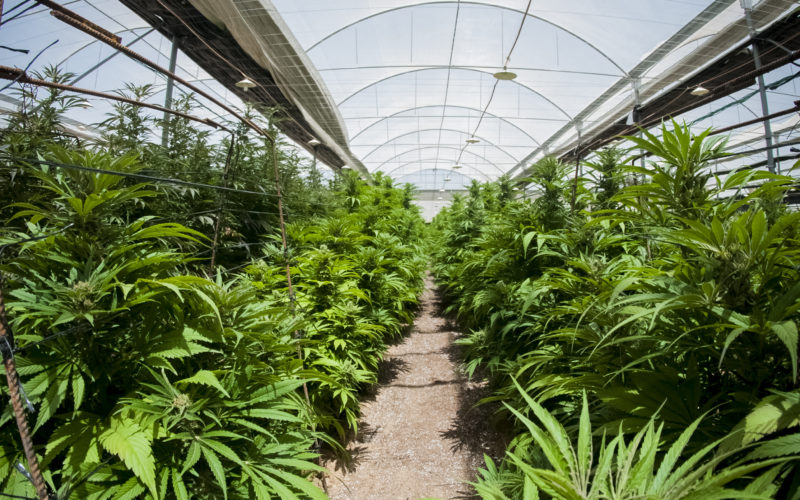
Setting Up A Cannabis Grow
No matter what kind of grower you are, there is no doubt that cannabis cultivation has crossed your mind. It can be a difficult market to break into, so two experts sat down to answer a few questions and explain some of the best practices for producing high-quality cannabis and how to succeed in a market that is becoming increasingly competitive.
Will Kacheris and Matt Sauls design custom grow systems for cannabis growers with GrowSpan. Kacheris has worked in several commercial greenhouses and has a master’s degree from the University of Arizona in Agricultural and Biosystems Engineering. Sauls has extensive experience in medicinal cannabis cultivation and has nearly 10 years’ experience designing cultivation systems with a focus on hydroponics and cannabis.
What’s the first thing every grower should start with if they’re looking to get into growing cannabis?
Will Kacheris: Understanding the marketplace and the actual price of the crop is important. A lot of growers think that no matter what they do, there’s going to be profits. This isn’t the case, and they have to examine the marketplace you’ll be growing in. I see a lot of people jumping into it and not understanding necessarily what the market is currently demanding.
Matt Sauls: From a business standpoint I totally agree. From a cultivation standpoint, environment is everything. Being able to control your environment is paramount in cultivating anything, but especially cannabis, so they have to make sure everything is in place to control the environment and then build around that.
When deciding between an indoor grow and a greenhouse, what are
the major factors?
MS: There are lots of challenges with large-scale cultivation in indoor facilities. If you’re going to make it profitable, you’re really going to have to maximize your use of square footage. You have to go vertical. You have to get energy-efficient lights. You have to maximize automation and minimize labor. You have to do all these things, because it much more expensive to operate the indoor environment versus a greenhouse.
WK: An indoor grow room is always going to be a high cost per pound. Also, the upfront cost is much higher. In greenhouses, we usually see anywhere from $35 to $50 per square foot, and that includes installation, freight, equipment, taxes, pretty much everything. That number quickly jumps to over $150 per square foot in an indoor grow, and that’s on top of high operating costs.
How can new growers maximize their profits?
MS: When new markets open up, the pattern we’re seeing is that there’s a high cost per pound, which at the time can justify a lot of expenses for setting up a large operation, but growers have to anticipate that the market will become more competitive. Prices are going to drop and they’re going to have to exist on thinner margins down the road. It makes sense to set up an operation in stages.
WK: Yes, smartly phasing in produces and expansions can definitely help maximize profits. For instance, with our GrowSpan greenhouses, we can add greenhouse bays one at a time. You can expand as you make cash, and that’s one of the smartest ways an operation can do it.
MS: Scaling up your greenhouse as production demands it is a really smart way to go about it. I see a lot of people investing in multimillion-dollar cultivation sites that may or may not be profitable in a few years when the price per pound is half of what it used to be. That’s the trend we’re seeing, so it makes sense to anticipate that.
WK: You can also do the same thing with automation. You can start
producing now and capture the current market rate, while it’s still high,
and then add things like automatic watering, computer control and climate
irrigation. That can all be phased in over time as cash flow allows.
Where do you see a lot of growers losing profit?
MS: Something I say regularly is don’t try to scale the closet grow. Basically, don’t take methods that worked in small-scale cultivation, which may have been born out of necessity, and try to scale it as a commercial business. It’s never going to work. Growers should look toward practices used in modern, large-scale agriculture.
WK: Another way I see a lot of waste is through misinformation and outdated growing methods. Most new cannabis growers are not utilizing university-level research to make decisions. Instead, they’re making decisions based on what YouTube or the internet is saying. Growers should use analytical research to drive changes in the grow. It’s a more commercial approach, and it can help to avoid costly mistakes.
What are some techniques or tools that growers often overlook, but
could help them maximize yield, quality and profits?
WK: Automatic irrigation systems are one of the least expensive and most time-saving units that I’ve seen out there. For a couple hundred dollars you can have a completely automated watering system that delivers a precise amount. It reduces heavy watering and extreme drying, so it can be a good way to prevent disease.
Also, you want to be able to efficiently move through your harvest. You want a perpetual harvest, where you have a separate space for clones and mothers, and then separate veg and flower rooms. By doing that you can cycle through and achieve a perpetual harvest.
MS: Growers need to set up a perpetual growth scenario like Will is talking about. Every two weeks you want to be harvesting, while simultaneously taking
cuttings and starting the process over again. You really don’t want to try and cram the entire workload into a couple weeks where you’re harvesting thousands of plants and need extra labor. With a perpetual cycle, you’re also providing products to customers on a consistent basis.
With greenhouses, we see a lot of light deprivation systems. Would you suggest that to growers?
MS: Yes. An automated blackout greenhouse can increase profitability by not only creating a year-round grow space, but with the built-in automation, grows can also reduce labor costs. It’s a win-win.
WK: If you’re just producing starts for field production, probably not, but everybody else can benefit from an automated light dep. greenhouse. If you use a blackout system in a greenhouse, you’ll be able to control the photo period and get more turns a year. Therefore, profits are increased. Additionally, blackout systems can be helpful if you’re in a populated area that has light pollution laws.
Anything else you want to add to help growers set up their cannabis op?
WK: Growers need to know the area and town they’ll be dealing with. I see a lot of growers that just try to buy the cheapest land they can find and then they figure they’ll deal with the town later. They need to make sure the town is open to the idea of growing cannabis and the methods the grow will be using. Talk to the town first, because they’re going to be a much larger headache then than the additional cost for purchasing land ever would be.
MS: I’m a big fan of adequate circulation and ventilation because operations can maximize the crop’s growth rate and metabolism by controlling those factors. Growers should definitely take that into consideration. That’s how growers get those massive yields. They’re really dialing in their environment to support the growth processes that’s going on inside these cannabis plants.









